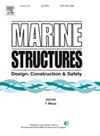A numerical prediction model for the global collision behavior of marine risers
IF 4
2区 工程技术
Q1 ENGINEERING, CIVIL
引用次数: 0
Abstract
This study develops a precise and efficient numerical model for predicting the global collision behavior of marine risers. Considering the combined effects of currents, random waves, top motions, and hydrodynamic interference, a dual-riser mechanical model is developed using the vector form intrinsic finite element (VFIFE) method. The point-value modeling method overcomes the limitations of displacement governing equations, eliminating the need for displacement constraint and stiffness matrix modification in the collision region. The issue of collision discontinuity is addressed using path elements. A two-stage collision detection strategy and an adaptive detection interval function, along with a self-developed collision detection algorithm, enhance efficiency without compromising accuracy. Additionally, the collision detection criteria are refined to avoid "pseudo-collisions." Upon detecting a riser collision, a rigid-body collision model is employed between collision path elements to correct riser element "penetration," thereby obtaining the true collision response. The model's accuracy is validated against ABAQUS results and is applied to analyze the global collision response of a tandem top-tensioned riser system. The results show that this model substantially improves calculation efficiency. Riser collisions are nearly line-line contacts and affect the downstream riser more than upstream riser. These collisions impact velocity response more than displacement. Normal collision velocities are much higher than tangential ones.
求助全文
约1分钟内获得全文
求助全文
来源期刊

Marine Structures
工程技术-工程:海洋
CiteScore
8.70
自引率
7.70%
发文量
157
审稿时长
6.4 months
期刊介绍:
This journal aims to provide a medium for presentation and discussion of the latest developments in research, design, fabrication and in-service experience relating to marine structures, i.e., all structures of steel, concrete, light alloy or composite construction having an interface with the sea, including ships, fixed and mobile offshore platforms, submarine and submersibles, pipelines, subsea systems for shallow and deep ocean operations and coastal structures such as piers.
 求助内容:
求助内容: 应助结果提醒方式:
应助结果提醒方式:


